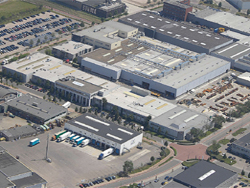 |
| Nederlands: Luchtfoto van Nederlands hoofdkantoor Bosch Rexroth (Photo credit: Wikipedia) |
One of the most difficult jobs of effective transportation planning, is the compromise between creating good environments for active transportation and transit while at the same time taking into considerations the need of freight carriers such as trucks that provide an important economic tool for many communities.
A great example of the problem areas for this compromise is in industrial areas. Industrial areas see a large amount of freight traffic (hopefully both on rail along with trucks) but you also need workers in industrial areas but they can be extremely difficult to serve with transit. Many transit advocates don't see the need for industrial areas and would love them to just go away. The problem with this line of thinking is that industrial areas tend to be the best sources of jobs that can lift people out of poverty. They provide a good paying jobs that do not require a college education.
The question is how do you serve industrial areas with transit and consider the last mile problem? One of the problems with transit service in these areas is that most of the ridership occurs only during shift changes which means if the industrial area is the primary point of travel for a transit line, it will only be busy during certain times of the day and run empty the rest of the time. There is a couple of solution to this problem.
One is to ensure that the industrial area is not the primary destination of the transit route. For example TriMet route 16 in Portland travels through the Northwest Industrial District but also serves downtown, the St. Johns area, Linnton and Sauvie Island. Two other routes the 15 and the 77 do terminate in the area but they are long routs and the industrial district makes up only a small portion of their total route mileage.
A second solution is to provide a shuttle service to the industrial area from a major transit stop. Companies such as Intel and Nike provide shuttle services from MAX light rail stations in Portland to their transit unfriendly campuses. Another example is the Burbank, CA Metrolink Commuter Rail station that sees a large number of company vans providing service from the train station to their offices although in this case they are not in industrial unfriendly industrial areas. In the cases cited the service is only provided by a specific company for their employees. A third example is in the Chicago Suburbs were employers pay the PACE transit agency to provide shuttle service from train stations to their businesses and these can be used by anyone willing to pay the fare.
Another problem presented by industrial areas is access by active transportation such as walking and bicycling. While few people will probably walk all the way to the industrial area from their homes, they may have to walk a distance from the bus stop to their place of employment and many times there is few if any sidewalks. A bigger problem is the conflict between trucks and bicyclist. Industrial areas can be congested with truck traffic that makes it dangerous for bicyclists. Trucks are large and have a hard time seeing cyclist in their mirrors. The best solution in this case is to provide dedicated infrastructure for bicyclists so they are separated from the trucks but not may not always be possible.
When bicyclists and trucks do have to share the road one of the most dangerous times is when a truck is making a turn because once the cab of the truck is at an angle it is very difficult for the driver to see what is on his right side. While there is no fail safe solution to this the problem, there is some relatively inexpensive things that can be done to increase safety. One would be to install mirrors along driveways giving truck drivers an additional way to see in their blind spots and the other would be put up more signage warning bicyclist and trucks of the dangers. A final idea would be an educational campaign that would teach both truckers and cyclists how to be safer around each other. The problem here is reaching the large number of long distance truck drivers who may come into the area only occasionally.
Industrial zones are important part of our economy but create unique transportation challenges especially when trying to serve them with transit and adding active transportation. It can be done but it takes cooperation from all parties to make a system that works.




